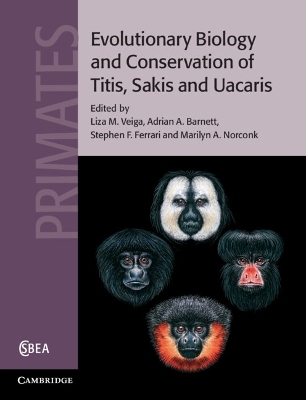
Evolutionary Biology and Conservation of Titis, Sakis and Uacaris
Cambridge University Press (Verlag)
978-0-521-88158-6 (ISBN)
The neotropical primate family Pitheciidae consists of four genera Cacajao (uacaris), Callicebus (titis), Chiropotes (bearded sakis) and Pithecia (sakis), whose 40+ species display a range of sizes, social organisations, ecologies and habitats. Few are well known and the future survival of many is threatened, yet pitheciines have been little studied. This book is the first to review the biology of this fascinating and diverse group in full. It includes fossil history, reviews of the biology of each genus and, among others, specific treatments of vocalisations and foraging ecology. These studies are integrated into considerations of current status and future conservation requirements on a country-by-country basis for each species. A state-of-the-art summary of current knowledge, Evolutionary Biology and Conservation of Titis, Sakis and Uacaris is a collective effort from all the major researchers currently working on these remarkable animals.
Adrian Barnett is an Honorary Research Fellow at the Instituto National de Pesquisas da Amazonas in Manaus, Brazil, and at the Centre for Research in Evolutionary and Environmental Anthropology at Roehampton University. He is a tropical biologist whose research focuses on rare, little-known and hard-to-find species and has spent fifteen years studying tropical primates, particularly the conservation and ecology of uacaris. Liza M. Veiga is a postdoctoral fellow at the Federal University of Pará and the Emílio Goeldi Museum, both in Belém, Brazil. Her research focuses on the conservation biology of the genus Chiropotes, Brazil. Stephen F. Ferrari is a Professor of Zoology in the Biology department of the Federal University of Sergipe, São Cristovão, Brazil. While his research covers a wide variety of mammalian taxa, he has a particular focus on the primate genera Callicebus and Chiropotes, their ecology and conservation. Marilyn A. Norconk is Professor of Anthropology at Kent State University, Kent, OH, USA. Her research focuses on behavioral ecology of South American monkeys, particularly feeding ecology and social behaviour of white-faced sakis and bearded sakis in Venezuela and Suriname.
Contributor list; Part I. Fossil History, Zoogeography and Taxonomy of the Pitheciids: 1. Pitheciidae and other Platyrrhine seed predators; 2. The misbegotten: long lineages, long branches and the interrelationships of Aotus, Callicebus and the Saki-Uacaris; 3. A molecular phylogeography of the Uacaris (Cacajao); 4. Taxonomy and geographic distribution of the Pitheciidae; 5. Zoogeography, genetic variation and conservation of the Callicebus personatus group; Part II. Comparative Pitheciid Ecology: 6. Morphological and ecological adaptations to seed predation - a primate-wide perspective; 7. Pitheciines: use of time and space; 8. Functional morphology and positional behaviour in the Pitheciini; 9. Male cooperation in Pitheciines: the reproductive costs and benefits to individuals of forming large multimale/multifemale groups; 10. Evolutionary ecology of the pitheciinae: evidence for energetic equivalence or phylogenetically structured environmental variation?; 11. Competition between Pitheciines and large Ara macaws, two specialist seed-eaters; 12. On the distribution of Pitheciine monkeys and Lecythidaceae trees in Amazonia; Part III. Genus Reviews and Case Studies: 13. Why we know so little: the challenges of fieldwork on the Pitheciids; 14. Ecology and behaviour of Uacaris (genus Cacajao); 15. Annual variation in breeding success and changes in population density of Cacajao calvus ucayalii in the Lago Preto Conservation Concession, Peru; 16. Cacajao ouakary in Brazil and Colombia: patterns, puzzles and predictions; 17. Ecology and behaviour of titi monkeys (genus Callicebus); 18. Costs of foraging in the Southern Bahian Masked Titi Monkey (Callicebus melanochir); 19. Insectivory and prey foraging techniques in Callicebus - a case study of Callicebus cupreus and a comparison to other pitheciids; 20. Seed eating by Callicebus lugens at Caparú Biological Station, on the lower Apaporis River, Colombian Amazonia; 21. Callicebus in Manu National Park: territory, resources, scent marking and vocalizations; 23. Feeding ecology of Uta Hick's Bearded Saki (Chiropotes utahickae) on a man-made island in southeastern Brazilian Amazonia: seasonal and longitudinal variation; 24. The behavioural ecology of Northern Bearded Sakis (Chiropotes satanas chiropotes) living in forest fragments of Central Brazilian Amazonia; 25. Ecology and behaviour of saki monkeys (genus Pithecia); 26. Finding the balance: optimizing predator avoidance and food encounters through individual positioning in Pithecia pithecia during travel; 27. Testing models of social behaviour with regard to inter- and intra-troop interactions in free-ranging white-faced sakis; 28. Comparative socioecology of sympatric, free-ranging white-faced and bearded saki monkeys in Suriname: preliminary data; 29. Pair-mate relationships and parenting in Equatorial Saki Monkeys (Pithecia aequatorialis) and Red Titi Monkeys (Callicebus discolor) of Ecuador; 30. Vocal communication in Cacajao, Chiropotes and Pithecia: current knowledge and future directions; Part IV. Conservation of the Pitheciids: 31. The Guyana Shield: Venezuela and the Guyanas; 32. Pitheciid conservation in Ecuador, Colombia, Peru, Bolivia, and Paraguay; 33. Brazil; 34. Pitheciines in captivity: challenges and opportunities, past, present and future; 35. The challenge of living in fragments; 36. Communities and Uacaris: conservation initiatives in Brazil and Peru; Appendix - country factsheets; Index.
| Erscheint lt. Verlag | 11.4.2013 |
|---|---|
| Reihe/Serie | Cambridge Studies in Biological and Evolutionary Anthropology |
| Zusatzinfo | 25 Plates, color; 88 Halftones, black and white |
| Verlagsort | Cambridge |
| Sprache | englisch |
| Maße | 223 x 282 mm |
| Gewicht | 1450 g |
| Themenwelt | Naturwissenschaften ► Biologie ► Evolution |
| Naturwissenschaften ► Biologie ► Ökologie / Naturschutz | |
| Naturwissenschaften ► Biologie ► Zoologie | |
| Sozialwissenschaften ► Soziologie | |
| ISBN-10 | 0-521-88158-7 / 0521881587 |
| ISBN-13 | 978-0-521-88158-6 / 9780521881586 |
| Zustand | Neuware |
| Haben Sie eine Frage zum Produkt? |
aus dem Bereich


